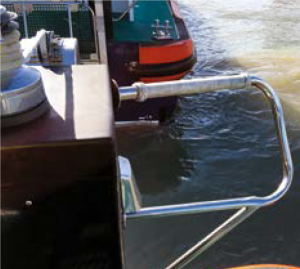The Charity
Aviation
Maritime
Pilot door design.

Initial Report
Outline:
Further to the article in MFB 48 concerning a vessel that was not constructed in compliance with SOLAS V 23, a second similar report has been received.
What the reporter told us:
This report concerns a new build vessel on her maiden voyage. The pilot boarded at the agreed pilot boarding area. On this occasion, the pilot access was via a “cat flap” which was positioned within the aft quarter length of the vessel. The stern camber profile started about 5m from the ladder’s position making it difficult for the pilot cutter to land properly and risking the cutter being sucked under the counter.
On the outward-bound passage of the same vessel, with a draft of 10.4m, the pilot cutter was damaged whilst trying to disembark two pilots via the cat flap. The cat flap disembarkation option was aborted and the vessel rigged a combination ladder from amidships from which the pilots were able to safely disembark.
All of the vessel’s other ladder equipment was observed to be in good order. The Owner should be informed of the difficulties this design caused, and pilot boarding arrangements reviewed before building any similar vessels.

Further Dialogue:
Investigation revealed that the vessel was built at the same shipyard as the report in Maritime FEEDBACK Issue 48, and with the same classification society, but had different owners and different flag.
CHIRP wrote to the managers of the vessel, the classification society, flag, and the shipyard. Whilst the letters to the ship managers and flag simply detailed the report, the letters to class and the shipyard highlighted the fact that the failings outlined in the previous report had not been rectified and that incidents were continuing. It was also highlighted that since both class and the yard had been involved in the modification to the previous vessels, as detailed in Maritime FEEDBACK Issue 48, it was unfortunate that lessons learned and acknowledged had not been taken forward for the new builds.
Although the managers of the vessel, the shipyard and the flag state all declined to respond, CHIRP did receive a response from the classification society. The salient points are highlighted below:
Our approval of the pilot boarding arrangements for this ship is based on a combination of two arrangements;
• The pilot-ladder located aft, for drafts above 13m, and
• The combination accommodation ladder and pilot ladder arrangement located amidships, for drafts, less than 13 m.
With this combination, our approval is in conformance with the SOLAS requirements.
The choice of the correct arrangement to be deployed is, as you will surely appreciate, an operational matter to be decided by the ship’s staff, depending upon the boarding conditions.
We assure you that we constantly strive to realise this Classification Society’s purpose, which is “to safeguard life, property and the environment” in all our endeavours.
CHIRP Comment:
The Maritime Advisory Board discussed this report in depth. Whilst thanking the classification society for their response, it was also noted that the approval was for this particular vessel and does not relate to the article published in Maritime FEEDBACK Issue 48.
The actual root cause of this incident and the one previously reported lies both in regulation and the initial approval at the design stage, (whilst noting that the classification society at the design stage may not necessarily be the same one as when the vessel is brought into service).
SOLAS Chapter V Regulation 23.3.1 states, “Arrangements shall be provided to enable the pilot to embark and disembark safely on either side of the ship.” Sub-section 3.3.1.2 further states it should be within the parallel body of the ship and, as far as practicable, within the mid-ship half length of the ship. If the wording in red is removed, the regulation becomes a directive, rather than a choice.
It is essential that classification societies work in conjunction with shipyards to ensure not only compliance with the letter of regulations, but also within their spirit to avoid hazardous situations and potential loss of life. Flag states have a duty to ensure compliance with regulations either directly or by oversight of designated bodies, i.e. classification societies. Ship owners should also take an active interest in the vessels that they purchase so that they are fit for purpose and do not unnecessarily endanger life.
Whilst an alternative option for a combination of an accommodation ladder and pilot ladder may exist, the temptation to use an alternative pilot door requiring less rigging, located in the aft quarter length of a ship in proximity to the propellers should not be an option. The danger to both the pilot cutter and pilot when such a location exists needs to be fully appreciated.
It is preferable to ‘design out’ rather than ‘design in’ a potential hazard resulting from an interpretation of imprecise wording in regulations, especially when the wording is intended for exceptional cases.
The following link may be helpful: IMPA Guidance for Naval Architects & Shipyards – Provision of Pilot Boarding Arrangements 2012
Report Ends………………..







